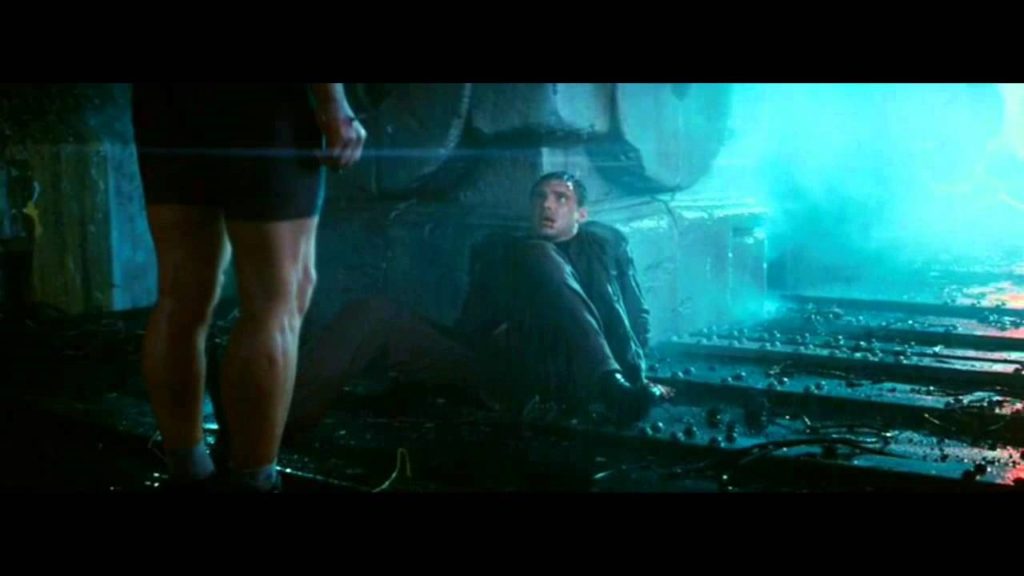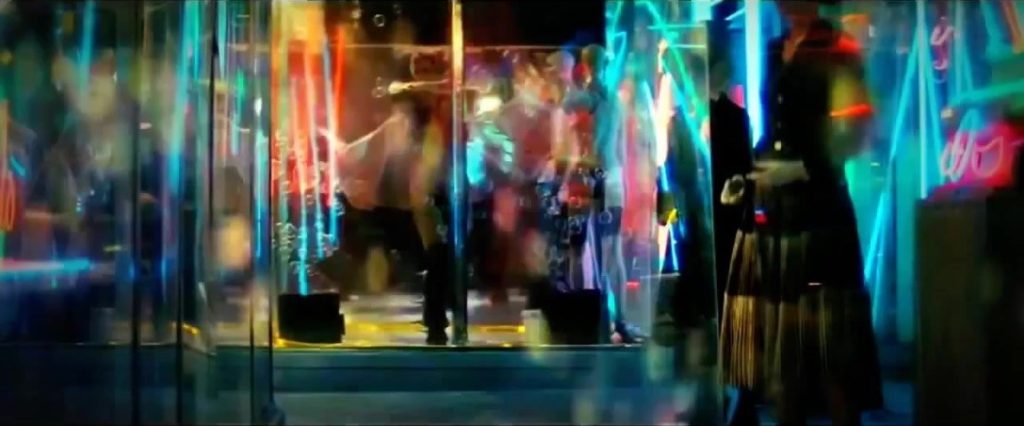Blade Runner was highly successful, outstanding piece of art. Not only is it visually appealing, but everything neatly ties together which develops the clarity of the film. Many aspects of Mise En scene are used to create a wonderful atmosphere within the film and add some verisimilitude to transport the audience into the world of Blade Runner
A scene of which I consider highly significant is the ending scene (referring to the US 1982 theatrical release edition). This is because I think that it cleverly utilises all aspects of Mise En scene to clarify the realism required for this film to work. In this particular shot, we can see that Batty is standing up whilst Deckard is on the ground. This clever balancing suggests that Batty believes that he is above and better than Deckard, who is trying to get away whilst in the mid-ground. Batty is positioned in the foreground, trapping Deckard from getting away. This is an interesting concept because it shows the arrogant nature of Batty who believes to have superiority over Deckard. The physical positioning of the shot reflects this, by physically towering Batty over Deckard. This particular shot is significant in developing the relationship between the two characters, which gives the audience an insight into the personality of the protagonist; Deckard

The fluorescent lighting used in this shot is significant in brightening up the dark scene, physically and also metaphorically. The bright, harsh and neon lights artificially light up the darkness of the night which brightens up the chiaroscuro of the setting compared to the stark white pigeon held by Batty. Overall, I would say excluding the neon artificial lighting provided by the commercial signs, that the lighting used is low-key. As the scene is deliberately set at night, there seems to be little natural lighting. This can convey the whole idea of a commercialised and also artificial future at the hands of technology. This is portrayed by the burst of bright, blue light which almost feels painful to the eye at the sheer brightness and unfamiliarity. I think this lighting creates an element of tension and suspense by forcing the audience to only focus on specific parts of the scene which are illuminated more than others. This diverges the focus to whatever the director wants by ensuring that the focal points are those which are constantly highlighted by the bright and shining light
I think the makeup used for Batty in his final scenes, perfectly portrays the character. Although he is smeared with violent slashes of blood, there is almost a childlike innocence with the way rain and tears have merged together. The simplicity of the makeup also works beautifully with the famously well-known ‘Tears in the rain’ monologue. This adds to the confusion about whether it is the rain staining his cheeks or the tears of which he is clearly trying to repress. Along with his prior reaction to seeing Pris dead, this allows the audience some sympathy for the antagonist because we are beginning to understand his feelings and thought process. This newly developed sympathy can be a factor in suggesting why the writers have decided to allow Batty to save Deckard, suggesting and expressing that he is an emotional and caring character despite his previous portrayal of being a blood thirsty, malicious replicant. This example of situation irony is interesting because although the film has nearly finished; it still ensures that his has lots of depth and twists to engage the audience right until the end

Film stock and aspect ratio plays a small yet important role in establishing the leitmotifs of the relationship between lighting and emotion. The film is typically set at night or late evening, maybe to set a gloomy tone. But the increased usage of bright and bold neon lighting helps to elevate this otherwise darkening tone to something of a wild atmosphere. Using the technique of night for night, and illuminating the fictional city with overly-bearing neon lights helps to categorise this film as neo-noir which adds more depth and structure
Costume does not play a vital role in this scene, mainly due to the fact that there are really only two characters (Deckard and Batty) that are shown. However; when Batty removes his shirt it signals that it is near the end. This physical change shown in his character is accompanied by the expression of his real personality as he saves Deckard before his inevitable death. This suggests that he is not in fact a villain, but rather a granted selfish, yet damaged individual

The setting bears great significance to the plot because it’s what easily emplaces verisimilitude within the audience. Personally, I think realism and verisimilitude are the hardest aspects of film to achieve successfully. This is because they are so challenging to get right, but if done to a strong extent; they can really set the atmosphere of a film. Science fiction can be a hard genre to make believable because everyone pictures different aspects of it in their head as its usually an imagined setting. I think the setting here is believable, because it was based on the world at the time with some adaptations. Nothing is too out-there, as even the flying cars which seems absurd, look somewhat realistic and not too futuristic to the point where they look fake. The large buildings are also aesthetically pleasing because they look realistic compared to some in the time, just upgraded
